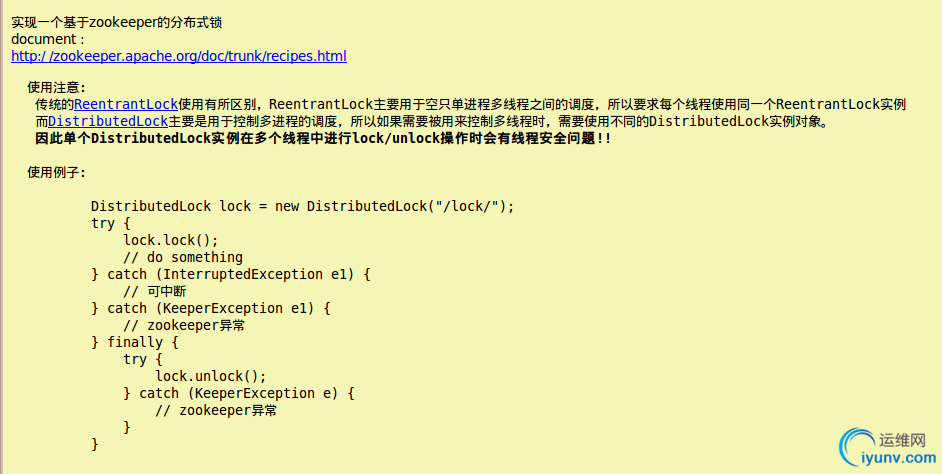|
|
背景
继续上一篇文章:http://agapple.iteye.com/blog/1183972 ,项目中需要对分布式任务进行调度,那对应的分布式lock实现在所难免。
这一周,在基于BooleanMutex的基础上,实现了zookeeper的分布式锁,用于控制多进程+多线程的lock控制
算法
可以预先看一下zookeeper的官方文档:
- http://zookeeper.apache.org/doc/trunk/recipes.html
lock操作过程:
- 首先为一个lock场景,在zookeeper中指定对应的一个根节点,用于记录资源竞争的内容
- 每个lock创建后,会lazy在zookeeper中创建一个node节点,表明对应的资源竞争标识。 (小技巧:node节点为EPHEMERAL_SEQUENTIAL,自增长的临时节点)
- 进行lock操作时,获取对应lock根节点下的所有字节点,也即处于竞争中的资源标识
- 按照Fair竞争的原则,按照对应的自增内容做排序,取出编号最小的一个节点做为lock的owner,判断自己的节点id是否就为owner id,如果是则返回,lock成功。
- 如果自己非owner id,按照排序的结果找到序号比自己前一位的id,关注它锁释放的操作(也就是exist watcher),形成一个链式的触发过程。
unlock操作过程:
- 将自己id对应的节点删除即可,对应的下一个排队的节点就可以收到Watcher事件,从而被唤醒得到锁后退出
其中的几个关键点:
- node节点选择为EPHEMERAL_SEQUENTIAL很重要。
* 自增长的特性,可以方便构建一个基于Fair特性的锁,前一个节点唤醒后一个节点,形成一个链式的触发过程。可以有效的避免"惊群效应"(一个锁释放,所有等待的线程都被唤醒),有针对性的唤醒,提升性能。
* 选择一个EPHEMERAL临时节点的特性。因为和zookeeper交互是一个网络操作,不可控因素过多,比如网络断了,上一个节点释放锁的操作会失败。临时节点是和对应的session挂接的,session一旦超时或者异常退出其节点就会消失,类似于ReentrantLock中等待队列Thread的被中断处理。
- 获取lock操作是一个阻塞的操作,而对应的Watcher是一个异步事件,所以需要使用信号进行通知,正好使用上一篇文章中提到的BooleanMutex,可以比较方便的解决锁重入的问题。(锁重入可以理解为多次读操作,锁释放为写抢占操作)
注意:
- 使用EPHEMERAL会引出一个风险:在非正常情况下,网络延迟比较大会出现session timeout,zookeeper就会认为该client已关闭,从而销毁其id标示,竞争资源的下一个id就可以获取锁。这时可能会有两个process同时拿到锁在跑任务,所以设置好session timeout很重要。
- 同样使用PERSISTENT同样会存在一个死锁的风险,进程异常退出后,对应的竞争资源id一直没有删除,下一个id一直无法获取到锁对象。
没有两全其美的做法,两者取其一,选择自己一个能接受的即可
代码
public class DistributedLock {
private static final byte[] data = { 0x12, 0x34 };
private ZooKeeperx zookeeper = ZooKeeperClient.getInstance();
private final String root; //根节点路径
private String id;
private LockNode idName;
private String ownerId;
private String lastChildId;
private Throwable other = null;
private KeeperException exception = null;
private InterruptedException interrupt = null;
public DistributedLock(String root) {
this.root = root;
ensureExists(root);
}
/**
* 尝试获取锁操作,阻塞式可被中断
*/
public void lock() throws InterruptedException, KeeperException {
// 可能初始化的时候就失败了
if (exception != null) {
throw exception;
}
if (interrupt != null) {
throw interrupt;
}
if (other != null) {
throw new NestableRuntimeException(other);
}
if (isOwner()) {//锁重入
return;
}
BooleanMutex mutex = new BooleanMutex();
acquireLock(mutex);
// 避免zookeeper重启后导致watcher丢失,会出现死锁使用了超时进行重试
try {
mutex.get(DEFAULT_TIMEOUT_PERIOD, TimeUnit.MICROSECONDS);// 阻塞等待值为true
// mutex.get();
} catch (TimeoutException e) {
if (!mutex.state()) {
lock();
}
}
if (exception != null) {
throw exception;
}
if (interrupt != null) {
throw interrupt;
}
if (other != null) {
throw new NestableRuntimeException(other);
}
}
/**
* 尝试获取锁对象, 不会阻塞
*
* @throws InterruptedException
* @throws KeeperException
*/
public boolean tryLock() throws KeeperException {
// 可能初始化的时候就失败了
if (exception != null) {
throw exception;
}
if (isOwner()) {//锁重入
return true;
}
acquireLock(null);
if (exception != null) {
throw exception;
}
if (interrupt != null) {
Thread.currentThread().interrupt();
}
if (other != null) {
throw new NestableRuntimeException(other);
}
return isOwner();
}
/**
* 释放锁对象
*/
public void unlock() throws KeeperException {
if (id != null) {
try {
zookeeper.delete(root + "/" + id, -1);
} catch (InterruptedException e) {
Thread.currentThread().interrupt();
} catch (KeeperException.NoNodeException e) {
// do nothing
} finally {
id = null;
}
} else {
//do nothing
}
}
private void ensureExists(final String path) {
try {
Stat stat = zookeeper.exists(path, false);
if (stat != null) {
return;
}
zookeeper.create(path, data, CreateMode.PERSISTENT);
} catch (KeeperException e) {
exception = e;
} catch (InterruptedException e) {
Thread.currentThread().interrupt();
interrupt = e;
}
}
/**
* 返回锁对象对应的path
*/
public String getRoot() {
return root;
}
/**
* 判断当前是不是锁的owner
*/
public boolean isOwner() {
return id != null && ownerId != null && id.equals(ownerId);
}
/**
* 返回当前的节点id
*/
public String getId() {
return this.id;
}
// ===================== helper method =============================
/**
* 执行lock操作,允许传递watch变量控制是否需要阻塞lock操作
*/
private Boolean acquireLock(final BooleanMutex mutex) {
try {
do {
if (id == null) {//构建当前lock的唯一标识
long sessionId = zookeeper.getDelegate().getSessionId();
String prefix = "x-" + sessionId + "-";
//如果第一次,则创建一个节点
String path = zookeeper.create(root + "/" + prefix, data,
CreateMode.EPHEMERAL_SEQUENTIAL);
int index = path.lastIndexOf("/");
id = StringUtils.substring(path, index + 1);
idName = new LockNode(id);
}
if (id != null) {
List<String> names = zookeeper.getChildren(root, false);
if (names.isEmpty()) {
id = null;//异常情况,重新创建一个
} else {
//对节点进行排序
SortedSet<LockNode> sortedNames = new TreeSet<LockNode>();
for (String name : names) {
sortedNames.add(new LockNode(name));
}
if (sortedNames.contains(idName) == false) {
id = null;//清空为null,重新创建一个
continue;
}
//将第一个节点做为ownerId
ownerId = sortedNames.first().getName();
if (mutex != null && isOwner()) {
mutex.set(true);//直接更新状态,返回
return true;
} else if (mutex == null) {
return isOwner();
}
SortedSet<LockNode> lessThanMe = sortedNames.headSet(idName);
if (!lessThanMe.isEmpty()) {
//关注一下排队在自己之前的最近的一个节点
LockNode lastChildName = lessThanMe.last();
lastChildId = lastChildName.getName();
//异步watcher处理
zookeeper.exists(root + "/" + lastChildId, new AsyncWatcher() {
public void asyncProcess(WatchedEvent event) {
acquireLock(mutex);
}
});
if (stat == null) {
acquireLock(mutex);// 如果节点不存在,需要自己重新触发一下,watcher不会被挂上去
}
} else {
if (isOwner()) {
mutex.set(true);
} else {
id = null;// 可能自己的节点已超时挂了,所以id和ownerId不相同
}
}
}
}
} while (id == null);
} catch (KeeperException e) {
exception = e;
if (mutex != null) {
mutex.set(true);
}
} catch (InterruptedException e) {
interrupt = e;
if (mutex != null) {
mutex.set(true);
}
} catch (Throwable e) {
other = e;
if (mutex != null) {
mutex.set(true);
}
}
if (isOwner() && mutex != null) {
mutex.set(true);
}
return Boolean.FALSE;
}
}
相关说明:

测试代码:
@Test
public void test_lock() {
ExecutorService exeucotr = Executors.newCachedThreadPool();
final int count = 50;
final CountDownLatch latch = new CountDownLatch(count);
final DistributedLock[] nodes = new DistributedLock[count];
for (int i = 0; i < count; i++) {
final DistributedLock node = new DistributedLock(dir);
nodes = node;
exeucotr.submit(new Runnable() {
public void run() {
try {
Thread.sleep(1000);
node.lock(); //获取锁
Thread.sleep(100 + RandomUtils.nextInt(100));
System.out.println("id: " + node.getId() + " is leader: " + node.isOwner());
} catch (InterruptedException e) {
want.fail();
} catch (KeeperException e) {
want.fail();
} finally {
latch.countDown();
try {
node.unlock();
} catch (KeeperException e) {
want.fail();
}
}
}
});
}
try {
latch.await();
} catch (InterruptedException e) {
want.fail();
}
exeucotr.shutdown();
}
升级版
实现了一个分布式lock后,可以解决多进程之间的同步问题,但设计多线程+多进程的lock控制需求,单jvm中每个线程都和zookeeper进行网络交互成本就有点高了,所以基于DistributedLock,实现了一个分布式二层锁。
大致原理就是ReentrantLock 和 DistributedLock的一个结合。
- 单jvm的多线程竞争时,首先需要先拿到第一层的ReentrantLock的锁
- 拿到锁之后这个线程再去和其他JVM的线程竞争锁,最后拿到之后锁之后就开始处理任务。
锁的释放过程是一个反方向的操作,先释放DistributedLock,再释放ReentrantLock。 可以思考一下,如果先释放ReentrantLock,假如这个JVM ReentrantLock竞争度比较高,一直其他JVM的锁竞争容易被饿死。
代码:
public class DistributedReentrantLock extends DistributedLock {
private static final String ID_FORMAT = "Thread[{0}] Distributed[{1}]";
private ReentrantLock reentrantLock = new ReentrantLock();
public DistributedReentrantLock(String root) {
super(root);
}
public void lock() throws InterruptedException, KeeperException {
reentrantLock.lock();//多线程竞争时,先拿到第一层锁
super.lock();
}
public boolean tryLock() throws KeeperException {
//多线程竞争时,先拿到第一层锁
return reentrantLock.tryLock() && super.tryLock();
}
public void unlock() throws KeeperException {
super.unlock();
reentrantLock.unlock();//多线程竞争时,释放最外层锁
}
@Override
public String getId() {
return MessageFormat.format(ID_FORMAT, Thread.currentThread().getId(), super.getId());
}
@Override
public boolean isOwner() {
return reentrantLock.isHeldByCurrentThread() && super.isOwner();
}
}
测试代码:
@Test
public void test_lock() {
ExecutorService exeucotr = Executors.newCachedThreadPool();
final int count = 50;
final CountDownLatch latch = new CountDownLatch(count);
final DistributedReentrantLock lock = new DistributedReentrantLock(dir); //单个锁
for (int i = 0; i < count; i++) {
exeucotr.submit(new Runnable() {
public void run() {
try {
Thread.sleep(1000);
lock.lock();
Thread.sleep(100 + RandomUtils.nextInt(100));
System.out.println("id: " + lock.getId() + " is leader: " + lock.isOwner());
} catch (InterruptedException e) {
want.fail();
} catch (KeeperException e) {
want.fail();
} finally {
latch.countDown();
try {
lock.unlock();
} catch (KeeperException e) {
want.fail();
}
}
}
});
}
try {
latch.await();
} catch (InterruptedException e) {
want.fail();
}
exeucotr.shutdown();
}
最后
其实再可以发散一下,实现一个分布式的read/write lock,也差不多就是这个理了。项目结束后,有时间可以写一下
大致思路:
- 竞争资源标示: read_自增id , write_自增id
- 首先按照自增id进行排序,如果队列的前边都是read标识,对应的所有read都获得锁。如果队列的前边是write标识,第一个write节点获取锁
- watcher监听: read监听距离自己最近的一个write节点的exist,write监听距离自己最近的一个节点(read或者write节点)
|
|
|